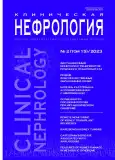Способ хирургического лечения рака мочевого пузыря у пациентов с терминальной стадией хронической почечной недостаточности, находящихся на заместительной почечной терапии программным гемодиализом с лечением и профилактикой гнойного пиелонефрита. Обзор клинических случаев
- Авторы: Трушкин Р.Н.1, Мартов А.Г.2,3,4, Соколов С.А.1, Исаев Т.К.1, Щеглов Н.Е.1, Тейхриб П.П.1
-
Учреждения:
- ГБУЗ «ГКБ № 52» Департамента здравоохранения г. Москвы, урологическое отделение
- ГБУЗ «ГКБ им. Д.Д. Плетнева» Департамента здравоохранения г. Москвы, отделение урологии (малоинвазивных методов диагностики и лечения урологических заболеваний)
- Медикобиологический университет инноваций и непрерывного образования ФГБУ ГНЦ ФМБЦ им. А.И. Бурназяна ФМБА России
- Медицинский научно-образовательный центр ФГБОУ ВО МГУ им. М.В. Ломоносова
- Выпуск: Том 15, № 2 (2023)
- Страницы: 37-43
- Раздел: Нефроурология
- Статья опубликована: 17.07.2023
- URL: https://journals.eco-vector.com/2075-3594/article/view/551812
- DOI: https://doi.org/10.18565/nephrology.2023.2.37-43
- ID: 551812
Цитировать
Полный текст
Аннотация
Введение. Рак мочевого пузыря (РМП) является одним из распространенных в мире среди злокачественных образований и занимает 7-е место в структуре онкопатологии у мужчин и 17-е место у женщин. Доказано, что пациенты, находящиеся на заместительной почечной терапии (ЗПТ), имеют более агрессивную опухоль и зачастую более серьезную стадию заболевания. В большинстве случаев на раннем этапе заболевания протекает бессимптомно и трудно подвергается скрининговой диагностике. Как правило, кинические проявления и диагностика наступают при мышечно-инвазивной стадии, где органосохраняющее лечение невозможно.
Клинические случаи. На базе ГБУЗ ГКБ № 52 с 2021 по 2023 г. прооперированы 2 пациента с мышечно-инвазивным РМП, с терминальной стадией хронической почечной недостаточности (тХПН), находящихся на ЗПТ программным гемодиализом. Всем больным выполнена лапароскопическая билатеральная нефроуретерэктомия, цистпростатвезикулэктомия, уретерэктомия единым блоком (ad bloc).
Результаты. Всем пациентам проведено малоинвазивное хирургическое лечение. Осложнений в раннем и позднем операционном периодах не получено, летальных случаев нет. По результатам гистологического исследования у всех пациентов ткань почек имеет склеротические изменения и истонченный уротелий без признаков опухолевого роста, моно- или билатеральной апостематозный пиелонефрит. У первого пациента – мышечно-инвазивный уротелиальный РМП pT2b N0. У второго – метастазы в лимфатические узлы малого таза. Также как случайная находка выявлен рак предстательной железы рT2N0 Глисон 6 (3+3). За период наблюдения на амбулаторном этапе данных за прогрессирование онкологического процесса не получено.
Выводы. На примере данных клинических случаев, можно убедиться, что радикальное лечение мышечно-инвазивного РМП у пациентов с тХПН является возможным в комплексе с удалением гнойно-септического очага, а в ряде случаев может являться профилактикой гнойно-септических осложнений. Однако при лечении данных заболеваний нужно применять мультимодальный подход к выработке оптимальных методов в диагностике и лечении.
Полный текст
Об авторах
Руслан Николаевич Трушкин
ГБУЗ «ГКБ № 52» Департамента здравоохранения г. Москвы, урологическое отделение
Автор, ответственный за переписку.
Email: uro52@mail.ru
ORCID iD: 0000-0002-3108-0539
д.м.н., заведующий урологическим отделением ГБУЗ «ГКБ № 52» ДЗМ
Россия, МоскваАлексей Георгиевич Мартов
ГБУЗ «ГКБ им. Д.Д. Плетнева» Департамента здравоохранения г. Москвы, отделение урологии (малоинвазивных методов диагностики и лечения урологических заболеваний); Медикобиологический университет инноваций и непрерывного образования ФГБУ ГНЦ ФМБЦ им. А.И. Бурназяна ФМБА России; Медицинский научно-образовательный центр ФГБОУ ВО МГУ им. М.В. Ломоносова
Email: martovalex@mail.ru
ORCID iD: 0000-0001-6324-6110
член-корреспондент РАН, д.м.н., профессор, заведующий кафедрой урологии и андрологии Медикобиологического университета инноваций и непрерывного образования ФГБУ ГНЦ ФМБЦ им. А.И. Бурназяна ФМБА России; заведующий отделением урологии (малоинвазивных методов диагностики и лечения урологических заболеваний) ГБУЗ «ГКБ им. Д.Д. Плетнева» ДЗМ, ведущий научный сотрудник Медицинского научно-образовательного центра ФГБОУ ВО МГУ им. М.В. Ломоносова
Россия, Москва; Москва; МоскваСергей Александрович Соколов
ГБУЗ «ГКБ № 52» Департамента здравоохранения г. Москвы, урологическое отделение
Email: sergey.sokolow@mail.ru
ORCID iD: 0009-0004-7016-2360
врач-уролог урологического отделения «ГБУЗ ГКБ №52 ДЗМ»
Россия, МоскваТеймур Карибович Исаев
ГБУЗ «ГКБ № 52» Департамента здравоохранения г. Москвы, урологическое отделение
Email: dr.isaev@mail.ru
ORCID iD: 0000-0003-3462-8616
к.м.н., врач-уролог урологического отделения «ГБУЗ ГКБ №52 ДЗМ»
Россия, МоскваНиколай Евгеньевич Щеглов
ГБУЗ «ГКБ № 52» Департамента здравоохранения г. Москвы, урологическое отделение
Email: nickshch@mail.ru
ORCID iD: 0000-0002-1018-8460
к.м.н., врач-уролог урологического отделения «ГБУЗ ГКБ №52 ДЗМ»
Россия, МоскваПетр Петрович Тейхриб
ГБУЗ «ГКБ № 52» Департамента здравоохранения г. Москвы, урологическое отделение
Email: teihrib_petr@mail.ru
ORCID iD: 0009-0001-0636-0571
врач-уролог урологического отделения «ГБУЗ ГКБ №52 ДЗМ»
Россия, МоскваСписок литературы
- Bray F., Ferlay J., Soerjomataram I., et al. Global cancer statistics 2018: GLOBOCAN estimates of incidence and mortality worldwide for 36 cancers in 185 countries. CA Cancer J. Clin. 2018;68:394–424.
- Lenis A.T., Lec P.M., Chamie K. Bladder Cancer: A Review. JAMA. 2020;324(19):1980–91. doi: 10.1001/jama.2020.17598.
- Martinez Rodriguez R.H., Buisan Rueda O., Ibarz L. Bladder cancer: Present and future. Med. Clin. (Barc). 2017;149(10):449–55. English, Spanish. doi: 10.1016/j.medcli.2017.06.009.
- Choyke P.L. Radiologic evaluation of hematuria: guidelines from the American College of Radiology’s appropriateness criteria. Am. Fam. Physician. 2008;78:347.
- Kurth K.H., et al. Current methods of assessing and treating carcinoma in situ of the bladder with or without involvement of the prostatic urethra. Int. J. Urol. 1995;2(Suppl. 2):8–22.
- Huang L., et al. The Diagnostic Value of MR Imaging in Differentiating T Staging of Bladder Cancer: A Meta-Analysis. Radiology. 2018;286:502.
- Chinnadurai R., Flanagan E., Jayson G.C., et al. Cancer patterns and association with mortality and renal outcomes in non-dialysis dependent chronic kidney disease: a matched cohort study. BMC. Nephrol. 2019;20:380.
- Nitta K. 2018 Annual Dialysis Data Report, JSDT Renal Data Registry. Nihon Toseki Igakkai Zasshi. 2020;52(12):679–754. doi: 10.4009/jsdt.52.679.
- Гумилевский Б.Ю., 2009.
- Sato Y., Kondo T., Takagi T., et al. Treatment strategy for bladder cancer in patients on hemodialysis: a clinical review of 28 cases. Int. Urol. Nephrol. 2016;48(4):503–9. doi: 10.1007/s11255-015-1199-2.
- Shariat S.F., et al. Outcomes of radical cystectomy for transitional cell carcinoma of the bladder: a contemporary series from the Bladder Cancer Research Consortium. J. Urol. 2006;176:2414.
- Mertens L.S., et al. Prostate sparing cystectomy for bladder cancer: 20-year single center experience. J. Urol. 2014;191:1250.
Дополнительные файлы









